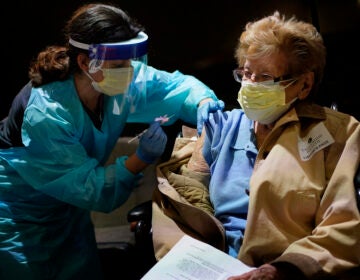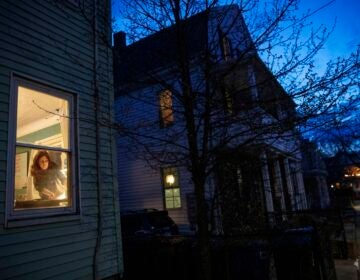Coronavirus update: Pa. Health Department addresses discrepancy in death counts
“At times there are things we need to review, and potentially revisit the way the data is being analyzed,” said Pa. Health Secretary Rachel Levine. “This is one of those times
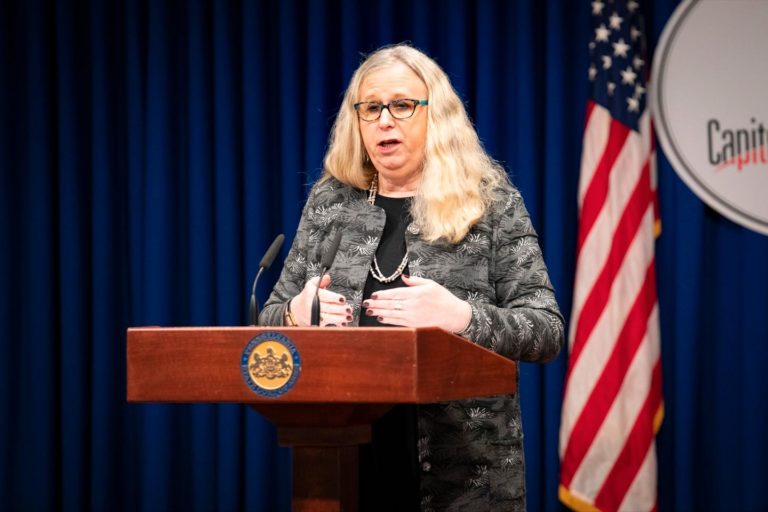
Pennsylvania Health Secretary Rachel Levine. (Commonwealth Media Services)
Updated at 5:25 p.m.
–
Are you on the front lines of the coronavirus? Help us report on the pandemic.
As of Thursday morning, the DOH is reporting 37,053 total COVID-19 cases in Pennsylvania (including confirmed and probable cases). There are 99,989 in New Jersey, and 3,308 cases in Delaware. Philadelphia has 11,226 cases.
Pennsylvania’s death toll stands at 1,421, New Jersey’s at 5,368, and Delaware’s at 92. Philadelphia’s death toll is 443.
Note: The Pa. number of total deaths has gone down because the state has changed the way it counts coronavirus-related deaths. See below.
State health department addresses discrepancy in death counts
The Pennsylvania Department of Health announced a state-wide total of 1,421 COVID-19-related deaths today, a decrease of 201 from the death count the department reported yesterday.
Rachel Levine, the state’s health secretary, said that probable deaths have been removed from the count because “further review has determined that we need more information before we can attribute them to a death related to COVID-19.”
“At times there are things we need to review, and potentially revisit the way the data is being analyzed,” she said. “This is one of those times.”
Today’s count of 1,421 deaths includes 27 probable deaths and 1,394 confirmed deaths, said Maggi Mumma, a spokesperson for the state health department.
Earlier this week, the state started to differentiate between numbers of confirmed and probable cases and deaths, based on the CDC’s definition of “probable.” A case is only considered confirmed when there is a positive result from laboratory testing. Probable cases are still under investigation.
Probable deaths are cases where a death is attributed to COVID-19 on the death certificate, Mumma said, but the deceased did not have a positive test or symptoms. “We have not reconciled those cases yet,” she said.
Levine added that investigations may take months to complete and some cases will remain probable even after investigation — “especially after someone tragically passes away, because we may never really be able to get a confirmed test.”
Levine said that county death numbers may also fluctuate because a patient’s county of residence is different from where they passed away. Cases and deaths should be counted by county of residence.
State officials will use confirmed counts to make decisions, such as whether to move a region from red to yellow, Levine said, but probable cases can help indicate if something is “happening in a community that requires further investigation.”
More details shared on plan to reopen state
In a press conference today, Pennsylvania Health Secretary Rachel Levine offered more details on how the state will make decisions about reopening regions.
One metric that’s been widely reported is that regions will meet the threshold for lifting stay-at-home orders after 14 days with an average of 50 cases per 100,000 individuals.
“But this is just one metric,” Levine said. She said this measure will be combined with other considerations, such as availability of testing, number of hospital beds, case management, contact tracing and modeling from Carnegie Mellon University.
“We’re putting all those together to make a final determination about reopening a region,” Levine said. She added that the state is working on determining which counties will be grouped into which regions.
Once a region has transitioned from a red to yellow designation, it will have to follow an “aggressive containment strategy,” Levine said, which includes watching for symptomatic individuals, isolating positive cases and doing extensive contact tracing for anyone who has tested positive.
“We have a plan that we’re finalizing about how contact tracing will be done,” Levine added.
Levine also announced that the state will begin relaxing criteria for COVID-19 testing, “and really start to look at anyone who might have symptoms.” Currently those at higher risk for COVID-19, such as seniors over 65, are prioritized for testing.
However, the state still won’t be able to conduct widespread testing of asymptomatic individuals. Levine said the state is exploring different ways to increase testing capacities, including mobile testing, mass-testing sites, and partnerships with Rite Aid or other businesses.
Wolf offers clarification on his new plan to reopen Pa.
On Wednesday evening, Governor Tom Wolf released his most detailed plans yet for allowing Pennsylvanians to return to work. But Thursday morning, he couched those plans somewhat, telling reporters that any decisions to reopen businesses would include a degree of subjectivity.
Wolf’s three-tiered system is color-coded.
Red designates the current situation, with a statewide stay-at-home order and only life-sustaining businesses allowed to be open. Yellow means that the stay-at-home order is lifted, and counties whose COVID-19 cases fall under a certain level can begin to let businesses with in-person operations reopen. Green means that nearly all restrictions are lifted, but businesses and individuals should still follow safety guidelines from the Centers for Disease Control and Prevention, like wearing a mask to go outside.
Read more details of Wolf’s reopening plan here.
Philadelphia’s new COVID-19 cases may be leveling off
Philadelphia is reporting that while case numbers are still high, the city’s numbers of new coronavirus infections has been relatively stable for the past few days.
There have been 583 new cases reported in the last 24 hours for a total of 11,226, and 20 new deaths for a total of 443 — numbers that Philadelphia Health Secretary Thomas Farley called “about average.”
Many of the new cases, he noted, were diagnosed in other areas of the state but weren’t initially classified as Philadelphia residents, and so are not technically new.
He also said Philadelphia is still seeing clusters of cases and deaths in places like nursing homes and jails.
Fifty-nine people incarcerated in city jails are currently infected, and ten of those cases are new. Four have recovered.
Of the city’s total deaths, 237 of them have been among nursing home residents.
Asked whether he’s satisfied with Governor Wolf’s plan to gradually reopen Pennsylvania, Kenney noted that the southeast region is a uniquely densely populated region of the commonwealth and as such, will need different standards for reopening than, for instance, a rural county like Tioga. Kenney said county and city leaders have been coordinating on the best responses.
Farley said Philadelphia’s health officials, meanwhile, are still studying Wolf’s plan and are cautiously optimistic about the broad strokes of the approach. However, he added, the plan is also just that: broad.
He said city leaders want more clarification on the standards for a county or city to move from the governor’s red to yellow to green designations, and are currently trying to get more details from the Wolf administration.
Pa. unemployment rate remains among nation’s highest
More than 1.5 million Pennsylvanians have filed for unemployment, more than any other state but California, since business closures began in mid-March to slow the spread of the coronavirus.
In all, 23% of the commonwealth’s workforce has submitted claims, the fifth-highest share in the nation, according to PA Post’s analysis of the latest numbers from the federal Department of Labor.
Nearly 200,000 claims were submitted last week alone in Pennsylvania, according to the DOL stats released Thursday. Those numbers don’t include gig workers and self-employed business owners in most states, pending the creation of new filing systems.
Pennsylvania’s Department of Labor and Industry launched its web portal for self-employed workers last weekend. Users reported confusion over how to complete some sections of the application and an inability to complete the process if they indicated receiving a W-2.
On Monday, the department posted a note on its website indicating it believed it had fixed the problem and that people eligible for Pandemic Unemployment Assistance — gig workers, some self-employed people, employees for certain religious groups — would no longer get an error message saying they were ineligible. It urged those workers to attempt the process again.
PA Post’s Emily Previti contributed reporting.
Bucks County reports shift from community spread to spread in long-term care facilities
Bucks County reported five additional COVID19-related deaths today, for a total of 123 deaths. As of today, the county has close to 2,300 confirmed cases of COVID-19.
David Damsker, director of the county’s health department, said that he’s seen a shift from community spread to spread in nursing homes, with one-half to two-thirds of recent cases occurring among residents and staff at long-term care facilities. More than 50 such facilities in Bucks County currently have outbreaks of the coronavirus.
“Once we get through the situation in the nursing homes, if the community spread is also down, then we’ll be in much better shape,” Damsker said, adding that the Health Department is working closely with long-term facilities to minimize COVID-19 spread and mortalities.
Bucks County commissioners Diane Ellis-Marseglia, Bob Harvie and Gene DiGirolamo said Governor Wolf’s plan for moving counties from red to yellow designation looked fair upon first glance. However, they are trying to get clarity on some points, like whether the southeastern portion of the state, including Philadelphia, would be treated as a region or as individual counties.
The plan “looks reasonable,” DiGirolamo said, but “I would love to see Bucks County have the flexibility to do what’s best for the residents of Bucks County. I would not like to see us lumped together with Philadelphia and surrounding counties and be in any way forced to do something that might not be in the best interest of Bucks County.”
DiGirolamo also expressed caution about opening up prematurely. “I think the worst thing that can happen is that we start opening up our businesses and everything else too soon, and this virus comes back, and we’re forced to go back to the very, very beginning.”
Bucks County, which has a population of 628,000, saw 1,297 cases over the past two weeks, for an average of 206 cases per 100,000 residents.
In estimating when Bucks County might approach the threshold Governor Wolf had designated for lifting stay-at-home orders — an average of 50 cases per 100,000 individuals over 14 days — Damsker, the health department director, said, “If we weren’t in the situation we’re in with nursing home facilities, I’d say we were much closer. That’s sort of the hang-up right now as to why our cases are still higher than we’d like.”
“Once we get through this very difficult hurdle of long-term care facilities and infections there with staff and residents, I believe we will be very close to looking at those numbers,” he said. He added that, in the last week or so, there’s been an increase in COVID-19 testing at facilities, and he should have a better sense of how the county’s nursing homes are doing in coming weeks.
PEMA is crowdsourcing information about where to get protective gear
Pennsylvanians can now use the state’s website to direct hospitals and first responders to spare medical supplies that are in high demand — like surgical and N95 masks, hand sanitizer, gloves and protective suits.
The commonwealth’s Emergency Management Agency announced the new online portal Thursday. PEMA Director Randy Padfield said he has been receiving “a lot of inquiries” from people who want to help first responders and medical workers, and is trying to “coordinate efforts for donations of larger quantities or for anyone who doesn’t know how to get these supplies to those who need them.”
COVID-19 cases have shown signs of stabilizing in Pennsylvania, but Padfield said equipment is still sorely needed.
The state has a guide detailing the criteria for appropriate protective gear, as does the CDC.
Montco officials are preparing residents for a long lockdown
Montgomery County officials say they’ve recorded 119 new positive cases in the past day, for a total of 3,212 cases overall. There have also been five new deaths, for a total of 179.
Val Arkoosh, chair of the county’s Board of Commissioners, noted that while numbers of new cases appear to be stabilizing across the commonwealth, and while Montgomery County’s hospitals all still have available beds, those open beds are filling up a little more every day.
“I don’t believe that we are over the peak in terms of hospitalized patients,” Arkoosh said. “I want to continue to urge everybody to stay at home except for the most essential trips.”
And even as Governor Wolf begins to lay out a road map for getting some counties back to work and slowly reopening Pennsylvania’s economy, Montgomery County officials aren’t planning for their turn to come any time soon.
“We need more testing of all types, I can’t say that enough,” Arkoosh said, adding that she thinks broader testing will be a key factor in enabling the county’s businesses to open more safely.
She said the county is expecting to receive a rapid-testing machine this week, but that while it will be helpful, one machine has nowhere near enough capacity to do the widespread testing health officials would ideally want to perform to track COVID-19 spread.
Arkoosh also said that as other counties begin letting their businesses reopen, she wants Montgomery County residents to think hard before traveling to patronize them.
“There will be no way that we can stop people from going to another part of the state where things are open,” she said. “But we will certainly encourage people to do that cautiously, and to follow all the social distancing guidelines … and remember that they could be carrying something from our region to another region.”
Because Montgomery County isn’t expecting to reopen in the near future, there’s a good chance that residents will still be under some sort of social distancing or stay-at-home order when it comes time to vote in the state’s June 2 primary election.
County officials, Arkoosh said, sent Governor Wolf and Secretary of State Kathy Boockvar a letter several weeks ago requesting that they be able to hold the election almost entirely by mail.
“That is just not going to happen,” Arkoosh said. “That request — I don’t want to say it was rejected — it would actually require legislation to effect that change, and that is just not in the cards.”
Arkoosh said instead, the county is urging everyone to vote by mail if at all possible — especially because many polling places won’t be able to open for the election because they are in high-risk long-term care facilities, and because many poll workers have decided not to volunteer for the primary.
WHYY’s Steph Yin contributed reporting.
WHYY is your source for fact-based, in-depth journalism and information. As a nonprofit organization, we rely on financial support from readers like you. Please give today.



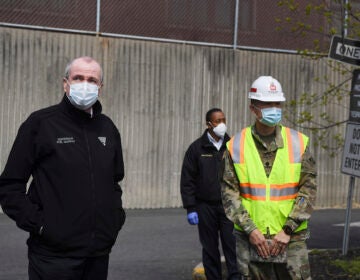
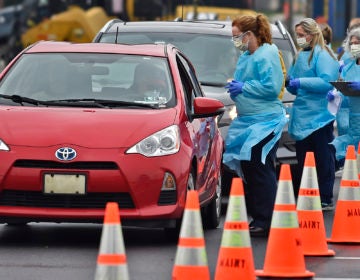
![CoronavirusPandemic_1024x512[1]](https://whyy.org/wp-content/uploads/2020/03/CoronavirusPandemic_1024x5121-300x150.jpg)
